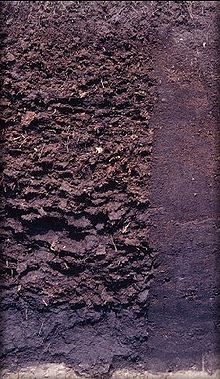Histosol
As histosol are soils with (possibly several meters) powerful organic horizons respectively. They are an order of the USDA Soil Taxonomy and a reference soil group of the World Reference Base for Soil Resources (WRB). Most histosols have formed under oxygen deprivation and water saturation ( peat ), but they can be found in cool regions even with a good oxygen supply. They occur mainly in the northern hemisphere and are found mainly in regions with a cold, wet climate in temperate latitudes and the boreal zone ( Western Siberia , Finland , Canada ), as well as in the Everglades in the US state of Florida , on Sumatra , in the Congo Basin and in the mangrove swamps of Asia.
Definitions
The definitions of the two systems are similar but not identical. In the Soil Taxonomy , the histosols can be found in the key after the gelisols , which is why organic permafrost soils belong to the gelisols (histels). In the WRB , the histosols separate out before the cryosols , which is why organic permafrost soils belong to the histosols (cryic histosols). The definitions of diagnostic organic material ( organic material ) are slightly different. In the WRB, at least 20% organic carbon is required for organic material. In the Soil Taxonomy it is 12 to 20%, depending on the water saturation and clay content . The minimum thicknesses of organic material required for a Histosol are similar: 60 cm if the organic material consists of at least three quarters of moss fibers, otherwise 40 cm. If the organic material lies directly on rock, skeleton or comparable subsoil, smaller thicknesses are sufficient for a Histosol.
The correlation with the German Soil Systematics ( KA5 ) is not that easy:
- The water-saturated histosols of the WRB all belong to soils of the Moore department . However, the water-saturated histosols of the Soil Taxonomy are only bogs if they contain at least 15% organic carbon. Conversely, only a part of the KA5 bog soils belong to the histosols, because the histosols have stricter thickness criteria and in some cases also stricter criteria for the organic carbon content.
- According to KA5, almost all of the non-water-saturated histosols belong to the rock and skeletal humus soils . But those are only histosols if they meet their criteria for the content of organic carbon and for the minimum thickness. The required thickness in the WRB is at least 10 cm, in the Soil Taxonomy it depends on the nature of the subsoil.
Origin, use and dissemination
Histosols arise on slightly sloping terrain with little activity of soil animals and microorganisms and thus very poor decomposition. Often, saturation of the soil with water prevents rapid degradation of the plant material. As a result, organic material builds up on the surface faster than it can be broken down, so that powerful organic soil horizons can form.
The pH value of histosols is usually in the acidic range, the nutrient content is low. Therefore, there is usually only sparse vegetation on Histosols. If they are drained, there is a great risk of wind erosion . Due to the high content of organic matter, Histosol components serve as fuel and are also broken down and used to obtain potting soil for horticulture .
Drainage of histosols leads to rapid mineralization of the organic material and the release of carbon dioxide . The drainage can be triggered by the thawing of permafrost as a result of global warming. In many places, however, it is brought about directly by humans, for example in Sumatra, where large areas are drained for the cultivation of oil palms.
The total area of all histosols worldwide is around 3.5 million square kilometers or 3 percent of the ice-free land area.
classification
The USDA Soil Taxonomy divides the histosols into five sub-orders:
See also
Web links
- Histosol's poster, US Department of Agriculture (USDA), 2005 (accessed February 8, 2013)
- Profile photos (with classification) WRB homepage
- Profile photos (with classification) IUSS World of Soils
literature
- Soil Survey Staff: Keys to Soil Taxonomy. 12th edition. Natural Resources Conservation Service. US Department of Agriculture. Washington DC, USA, 2014.
- IUSS Working Group WRB: World Reference Base for Soil Resources 2014, Update 2015. World Soil Resources Reports 106, FAO, Rome 2015. ISBN 978-92-5-108369-7 ( PDF 2.3 MB).
- W. Zech, P. Schad, G. Hintermaier-Erhard: Soils of the world. 2nd Edition. Springer Spectrum, Heidelberg 2014. ISBN 978-3-642-36574-4 .
- W. Amelung, H.-P. Blume , H. Fleige, R. Horn, E. Kandeler , I. Kögel-Knabner , R. Kretschmar, K. Stahr , B.-M. Wilke: Scheffer / Schachtschabel textbook of soil science. 17th edition. Heidelberg 2018. ISBN 978-3-662-55870-6 .
- Ad-hoc Working Group Soil: Soil Science Mapping Instructions, Ed .: Federal Institute for Geosciences and Raw Materials in cooperation with the State Geological Services, 5th edition, 438 p .; 41 fig., 103 tab., 31 lists, Hanover 2005. ISBN 3-510-95920-5 ( http://www.schweizerbart.de/pubs/isbn/bgr/bodenkundl-3510959205-desc.html )

